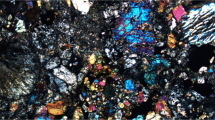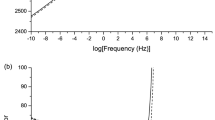Abstract
DR T. B. ANDERSON1 considers that kink-bands are symmetrically distributed about a planar anisotropy caused by cleavage, and that this is indicative of the major principal pressure acting within the cleavage. This is not justified since in rocks with strong planar anisotropism there is no basis for interpreting “a component parallel to the strike of the s-surface”1,2 as the maximum principal pressure. Indeed, according to Hoeppener3, the view that the maximum principal stress bisects the obtuse dihedral angle may be fallacious.
Similar content being viewed by others
References
Anderson, T. B., Nature, 202, 272 (1964).
Flinn, D., Geol. Mag., 89, 263 (1952).
Hoeppener, R., Geol. Rundschau, 45, 269 (1956).
Hoeppener, R., Geol. Rundschau, 44, 29 (1955).
Marshall, B., Proc. Ussher Soc., 1 (1962).
Hills, E. S., Outlines of Structural Geology, 124 (Methuen and Co., Ltd., London, 1940).
Engels, B., Geotekt, Forsch., 13, 76 (1959).
Hubbert, M. K., Geol. Soc. Amer. Bull., 62, 355 (1951). McKinstry, H. E., Amer. J. Sci., 251, 411 (1953).
Ramsay, J. G., Geol. Mag., 99, 525 (1962).
Author information
Authors and Affiliations
Rights and permissions
About this article
Cite this article
MARSHALL, B. Kink-bands and Related Geological Structures. Nature 204, 772–773 (1964). https://doi.org/10.1038/204772b0
Issue Date:
DOI: https://doi.org/10.1038/204772b0
- Springer Nature Limited
This article is cited by
-
Kink-bands and Related Geological Structures
Nature (1967)
-
Kink-bands and Related Geological Structures
Nature (1966)





